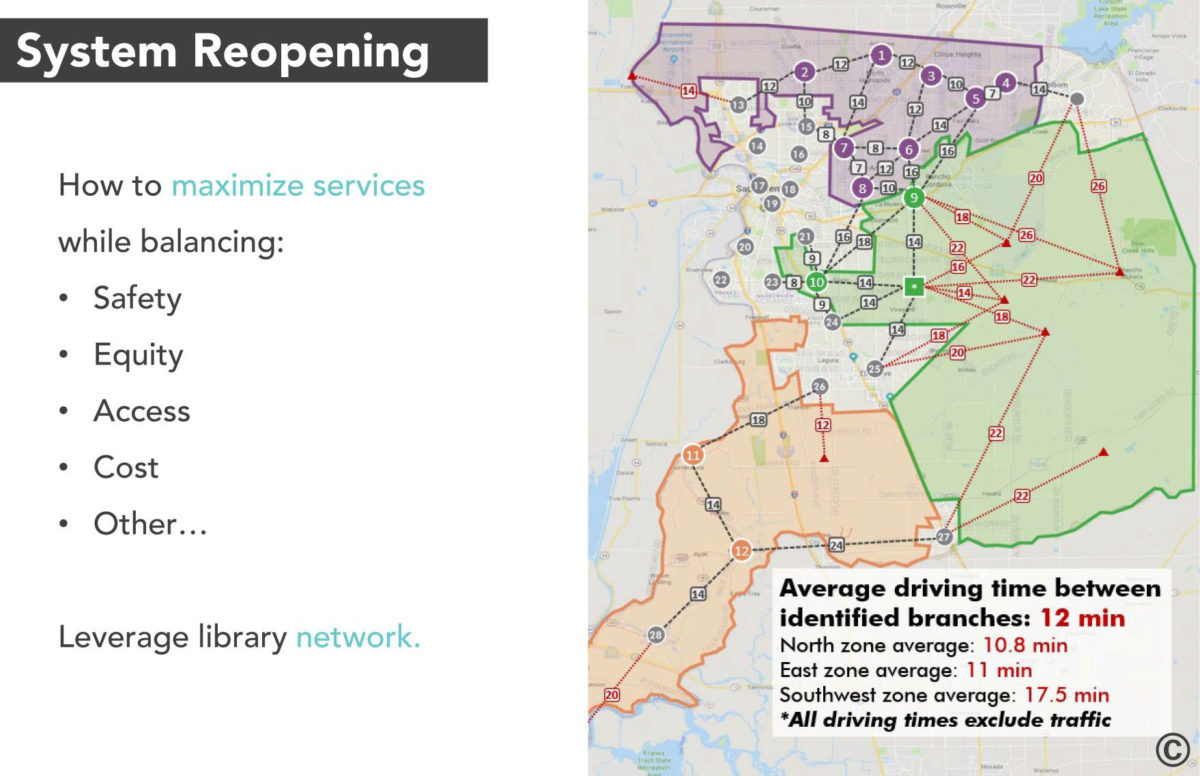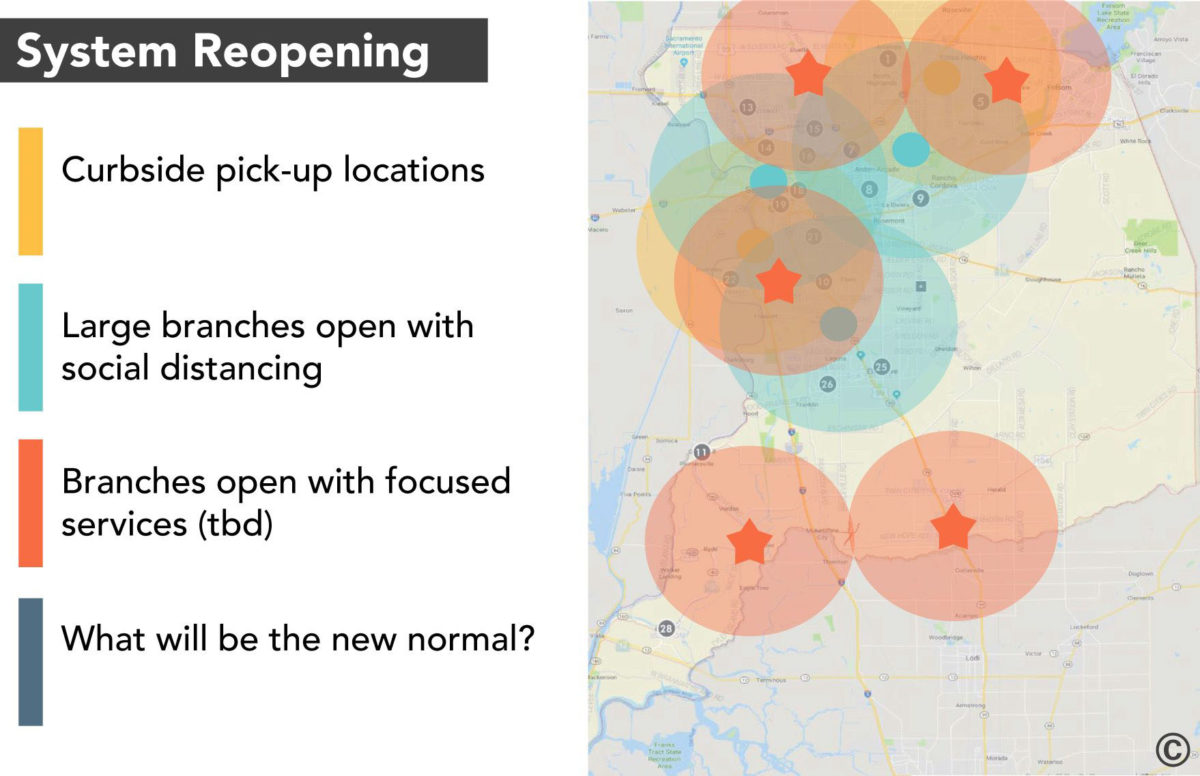Library leaders and designers explore COVID-19 challenges and opportunities
In March 2020, most libraries in the United States closed their doors as their communities battled the spread of COVID-19. During the shutdown, these libraries found creative ways to continue serving and engaging their customers – including diverse online programming as well as expanded access to digital collections. Many libraries also rolled up their virtual sleeves to help communities deal with the pandemic, such as using their 3D printers to make PPE for health care workers, providing assistance with filing for government relief programs, and even making wellness calls to senior patrons.
As communities begin to emerge from shelter-in-place, their libraries have been preparing to re-open their physical spaces. Questions that many libraries have been asking include:
- How can we modify our spaces to keep patrons and staff safe?
- Should we rethink our furniture, fabrics, and finishes?
- How do we make near-term changes for safety that don’t limit flexibility?
- What are the implications for service, operations, and the customer experience in our spaces?
- What is feasible within anticipated budget reductions?
Even as they focus on the near-term issues around re-opening, libraries are also keeping an eye on the future. Many libraries have facility master plans, renovations, and new building projects underway, and want to understand how the pandemic should impact design decisions. Many recognize COVID-19 as the kind of disruption that, along with its challenges, presents unique opportunities to make strategic changes. Big questions for libraries about the long-term future include:
- Could this disruption facilitate or accelerate moves to new models of service?
- What is the library’s role in providing public space?
- What role will the physical collection play in our space?
- How do we involve staff, stakeholders, partners, and the public in charting our future?
On May 15, 2020, more than 40 library professionals, architects, and other thought leaders from across the country came together to explore these questions and share ideas. Facilitated as a virtual salon by Group 4 Architecture, the session began with a polling on participant outlook. Very few participants saw the pandemic as an existential threat to libraries. Rather, most were confident in the library as a resilient institution that will weather this crisis, and saw this disruption as an opportunity to reinvent themselves.
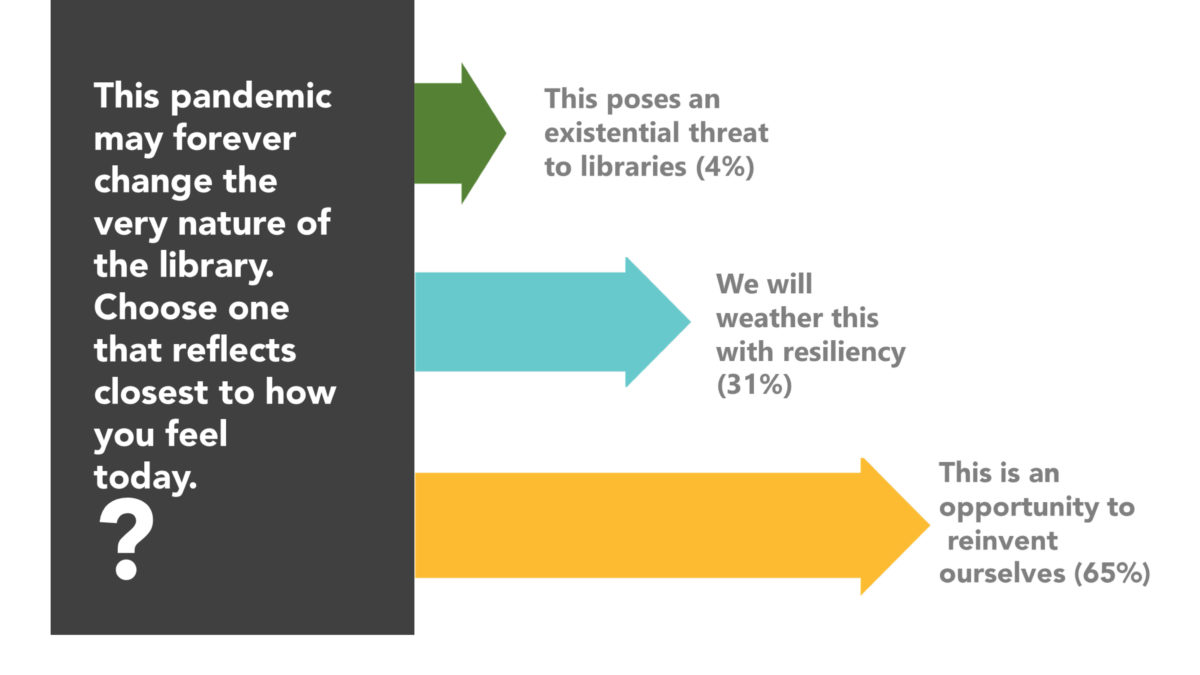
Throughout history, communities have always come back together into shared spaces – even after global pandemics such as the Spanish flu in the early 20th century. In the spirit of optimism, the salon began with the assumption that our communities will again regather and rebuild in shared spaces. The challenge for the group was to imagine the future of library space that we should create.
This challenge was considered in two timeframes: mid-term, as communities remobilize and build broader immunity to COVID-19; and long-term, when communities have regained confidence about gathering in public spaces.
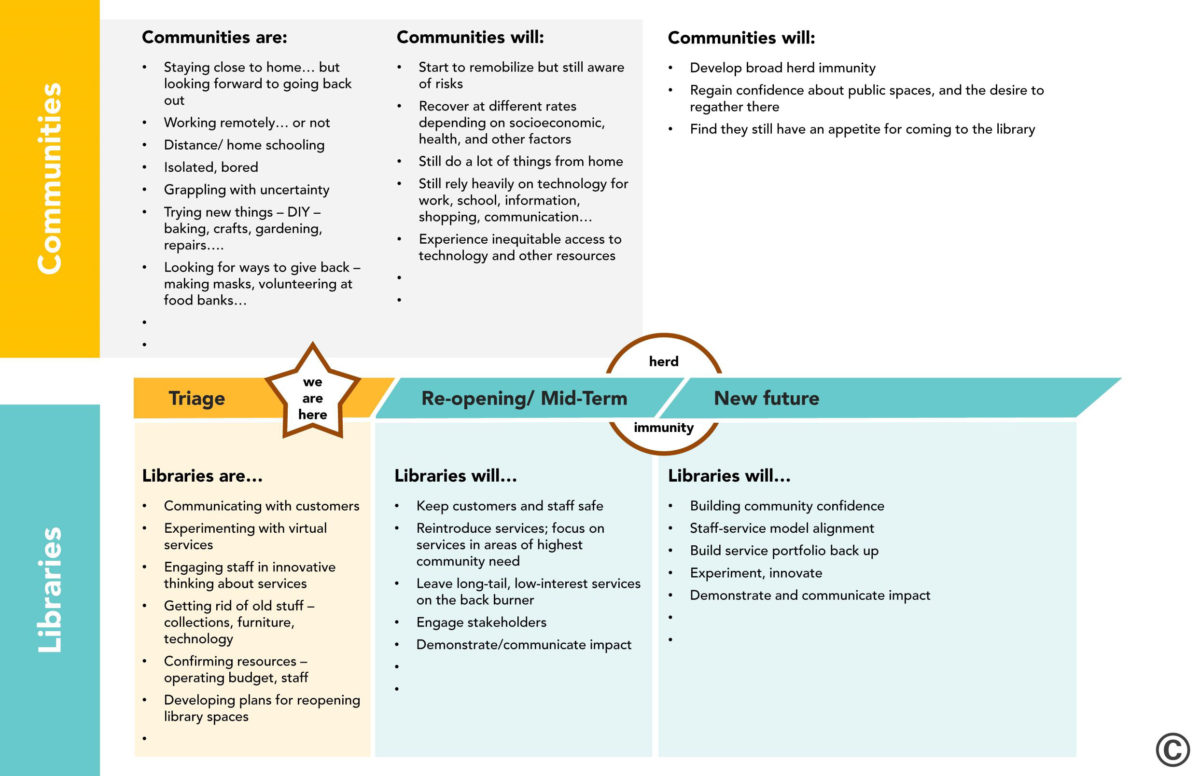
Salon participants shared ideas and explored opportunities for the future of library spaces in breakout groups organized around: comfort and safety, operations, customer experience, equity, and vision. Some common concepts and themes emerged from these rich discussions.
Safety and Comfort for Patrons and Staff
As the world’s understanding of the COVID-19 virus has evolved over the past few months, so have the guidelines for maintaining safe spaces – including furniture and equipment spacing, staff and customer circulation patterns, ventilation and air conditioning, signage, and more. Libraries are working on how to comply with these guidelines in a way that also achieves the welcoming, comfortable feel that their patrons expect and appreciate.
Some of the equipment and spaces that have become core library services in the 21st century may feel complicated to try to manage – particularly in times of heightened social distancing and cleaning requirements. Library computers – which are vital for bridging the digital divide and ensuring equitable access to technology – typically have not been designed for the robust cleaning protocols and products required to minimize transmission of the virus between users. Small group study/collaboration spaces and even larger meeting rooms – which have been in increasingly high demand in most communities – suddenly are no longer usable in the same way.
In recent years, a major trend in library design has been an increasing focus on investing in flexibility with reconfigurable spaces, movable furniture and shelving, and robust power and data infrastructure. These make it easier to accommodate changing interior layouts and activities in both the mid- and long-terms. Some libraries are looking to health care environments for examples of furnishings that are easy to clean, and there are many choices today that are attractive and comfortable.
lower spatial risk
An informative New York Times opinion piece explored the comparative health risks of visiting different types of businesses by comparing duration of visit and density of occupancy. Applying a similar methodology to different public library spaces helps focus our attention on where we need to find strategies to lower spatial risk. Common sense strategies such as spreading out customers, finding bigger spaces, offering multiple program sessions, and extending hours are among the ways capacity can be maintained for in-library services.
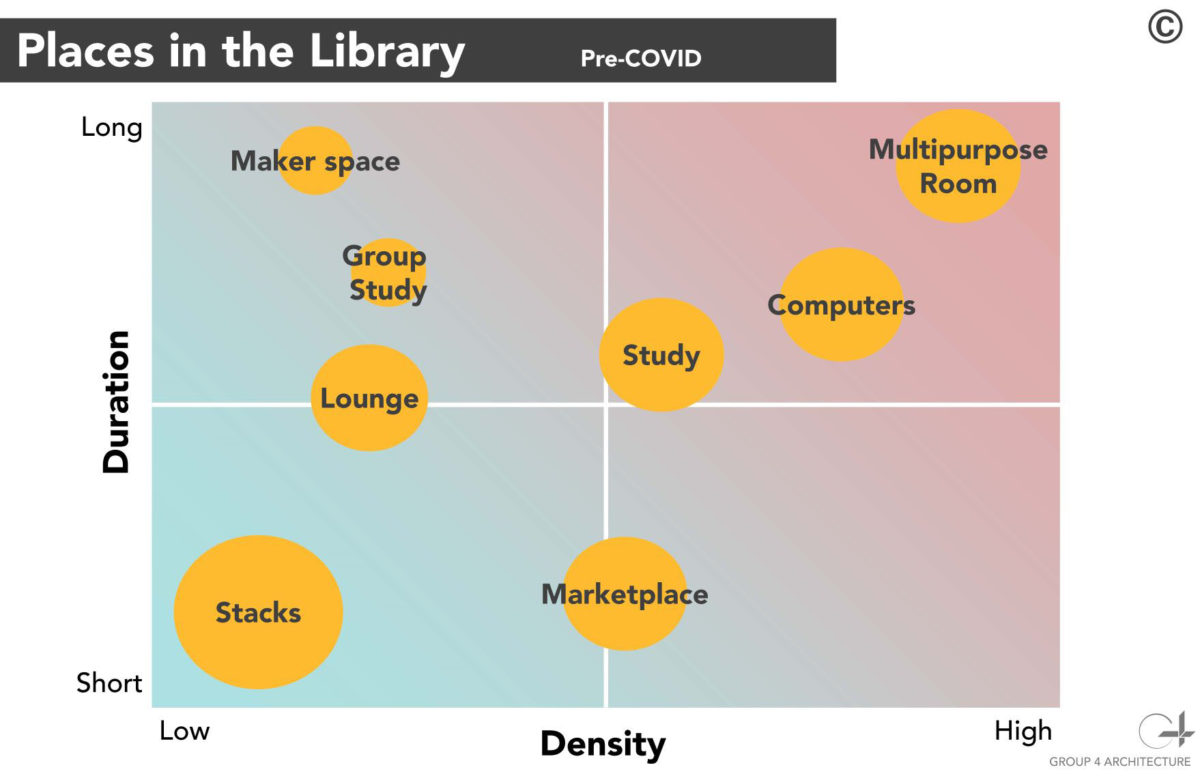
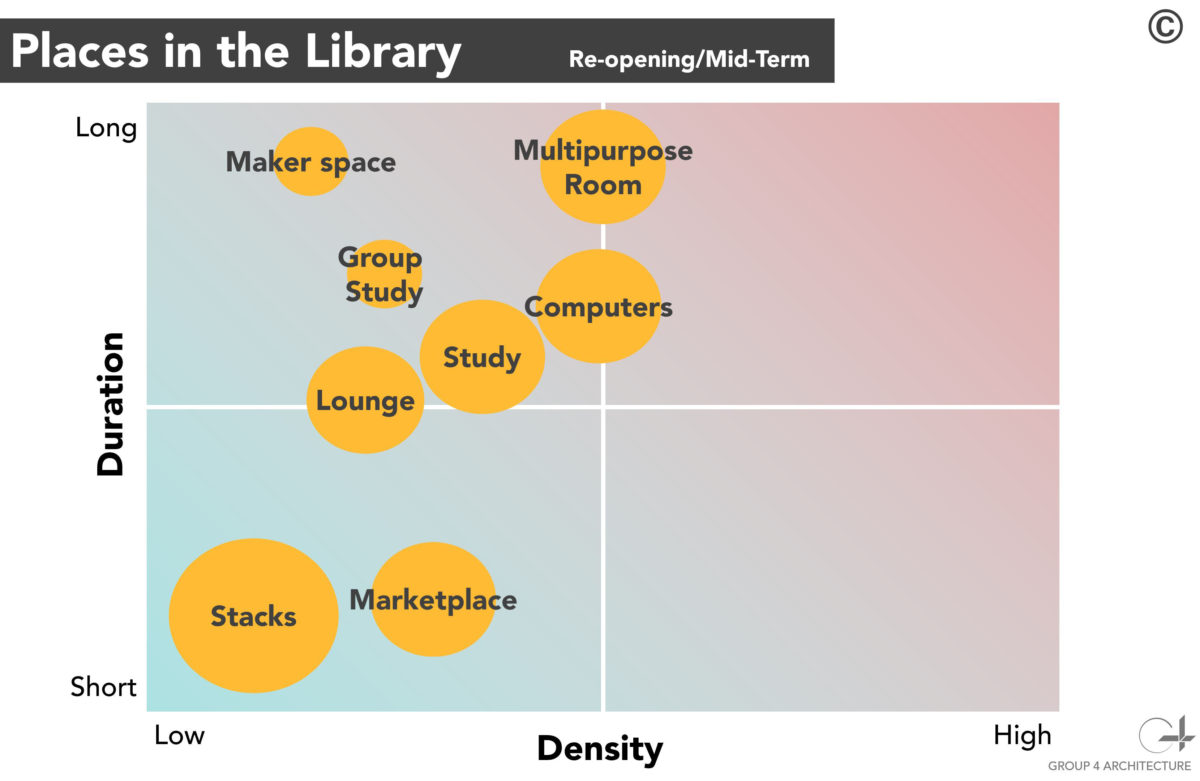
Operational Opportunities
As libraries move toward re-opening, they are considering which services to re-introduce and when. How many people their spaces can accommodate safely is one consideration, along with the appropriate services that can be offered in those spaces. Operating budget reductions are another significant factor; as communities are affected by the disruption of local, national, and global economies, so are their libraries. Many libraries are expecting – or have already begun to experience – moderate to major budget reductions that will affect the level of service they can provide.
Group 4’s research of multi-branch library systems has shown that in communities with high levels of mobility, customers routinely use multiple branches to meet their needs and to fit their lifestyles. This enables libraries to plan their operations as a network, with the potential for different libraries to serve different roles. This can be a particularly powerful mid-term and long-term post-pandemic strategy.
Participants discussed a variety of potential operational strategies for multi-facility library systems, including:
- Focused services. Temporarily providing a narrower range of services that can be appropriately staffed and resourced is one strategy that libraries can consider. A number of participants spoke about the importance of prioritizing access to technology and other services for vulnerable and underserved populations. Libraries also are considering opportunities to expand and enhance their support for remote living while their communities phase out of lockdown. Participants in several breakout groups noted the opportunity to continue emphasizing digital materials in the near- and mid-terms, and bring physical collection access back to full strength later.
- Focused facilities. Trying to achieve a “full-service library” with social distancing and associated operational implications can be very challenging – particularly in smaller facilities. Larger library systems can explore the feasibility, cost-effectiveness, and appeal of modifying some of their facilities to support specific services. The Vision breakout group explored concepts such as “browsing-only” branches and technology-focused libraries that could be designed for optimum occupancy, easy cleaning, and operation by appropriately-skilled staff.
- Focused hours. Focused services and facilities offer the opportunity to tailor the hours of operation. A branch focused on children’s services, for example, could be operated for different (and perhaps fewer) hours than a branch offering a broader set of services. Session participants noted that the operational advantages of focused facilities would need to be weighed carefully against the desire to offer customers predictable hours and predictable services – as well as the desire to accommodate the diverse interests of families visiting libraries together.
Equity
On the lintel above many public library entries is the engraving “open to all.” Inside its doors, the library is one of the few places where the rich diversity of our community can be seen sharing the same spaces. In the equity breakout group, concern was expressed about pandemic responses focusing disproportionately on popular versus essential services, elected officials paying lip service to equity, and heightened political divisiveness pulling at the threads of community fabric.
In addition to providing access to materials and services, libraries provide essential places for people to study and work, to gather and collaborate, and to meet and connect with others. The library is particularly important to those who have limited access to other private or commercial spaces. With possible branch closures due to budget shortfalls and reduced occupancy in socially distant spaces, salon participants discussed the need to prioritize space use through a lens of equity. This is especially relevant for unhoused members of the community.
In response to the pandemic, many libraries have increased their digital collections and increased the array of programs and services available online. While libraries were shut down, many slow adopters of new technology overcame barriers and are now using mobile services and attending virtual programs for the first time. The inevitable change in service models could be an opportunity to remove old barriers to access, while creating a synthesis between the digital and physical worlds. But those without access to a personal computer, smartphone, or adequate bandwidth are left out. Salon attendees discussed the need to prioritize space in the library to bridge the digital divide.
In recent years, libraries have become increasingly creative in providing services in non-traditional locations such as in community and senior centers, in parks, and at community gatherings. Participants were optimistic that the COVID-19 disruption may lower some of the barriers to more types of embedded service opportunities.
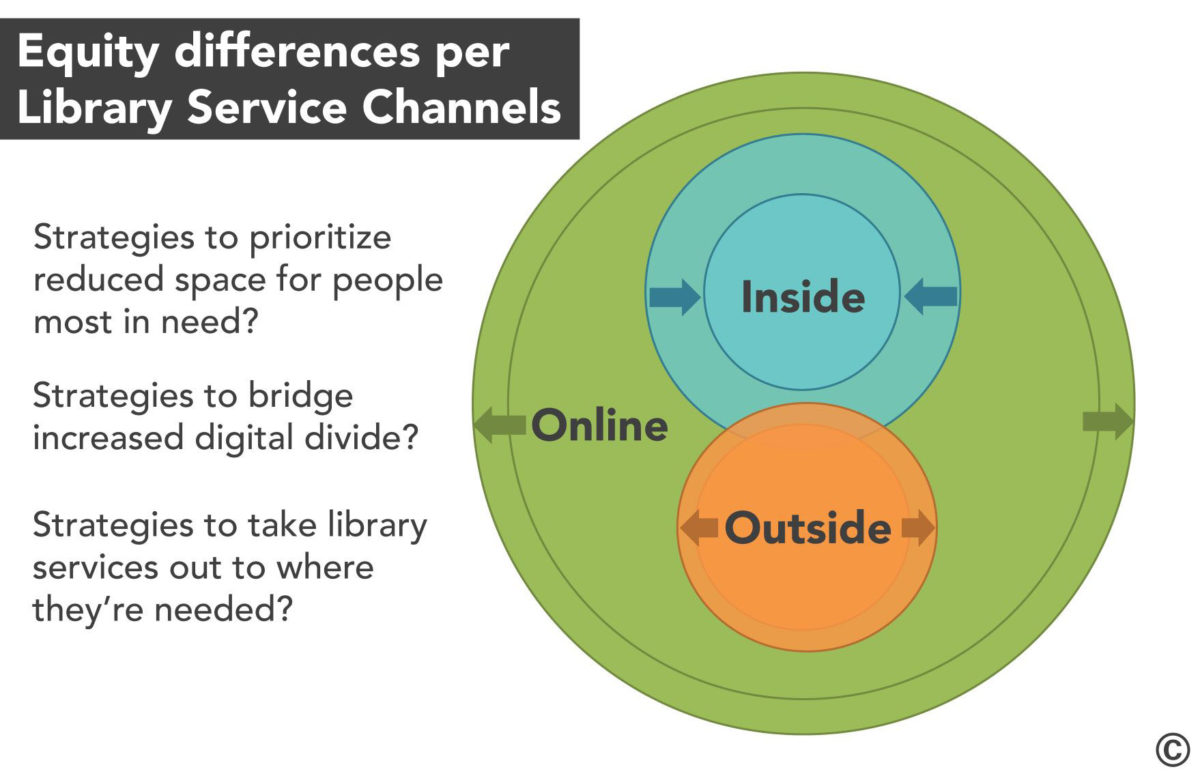
Expanding Reach and Building Support
Necessity is the mother of invention, and libraries have been some of the most passionate and creative inventors during these uncertain times. The Sacramento Public Library reports that its virtual programming has increased its customer base; 88% of participants at one of its virtual programs in May were attending a library program for the first time. SPL and many other libraries have also experienced a significant increase in cardholders as well as circulation of digital materials. Such results cannot be attributed just to community isolation and boredom during shelter-in-place; these successes also reflect the ongoing dedication and commitment of library staff.
Libraries recognize that their communities are always changing and will continue to do so in the future. Successful libraries see change as a chance to address old inequities and barriers, experiment and innovate, and build a better service platform. Salon participants see an opportunity to create a more seamless synthesis of the digital and physical – including spaces as well as services. Libraries that have been wrestling with large, legacy collections are exploring new ways to talk with their communities about the role those materials should play in future service and spaces. (While temporarily out of the public eye, some libraries have seized the opportunity to weed low-circulating materials and right-size physical collections to support more flexible library spaces.) And libraries are continuing to identify and build partnerships that complement their strengths, enhance their service, and increase their impact.
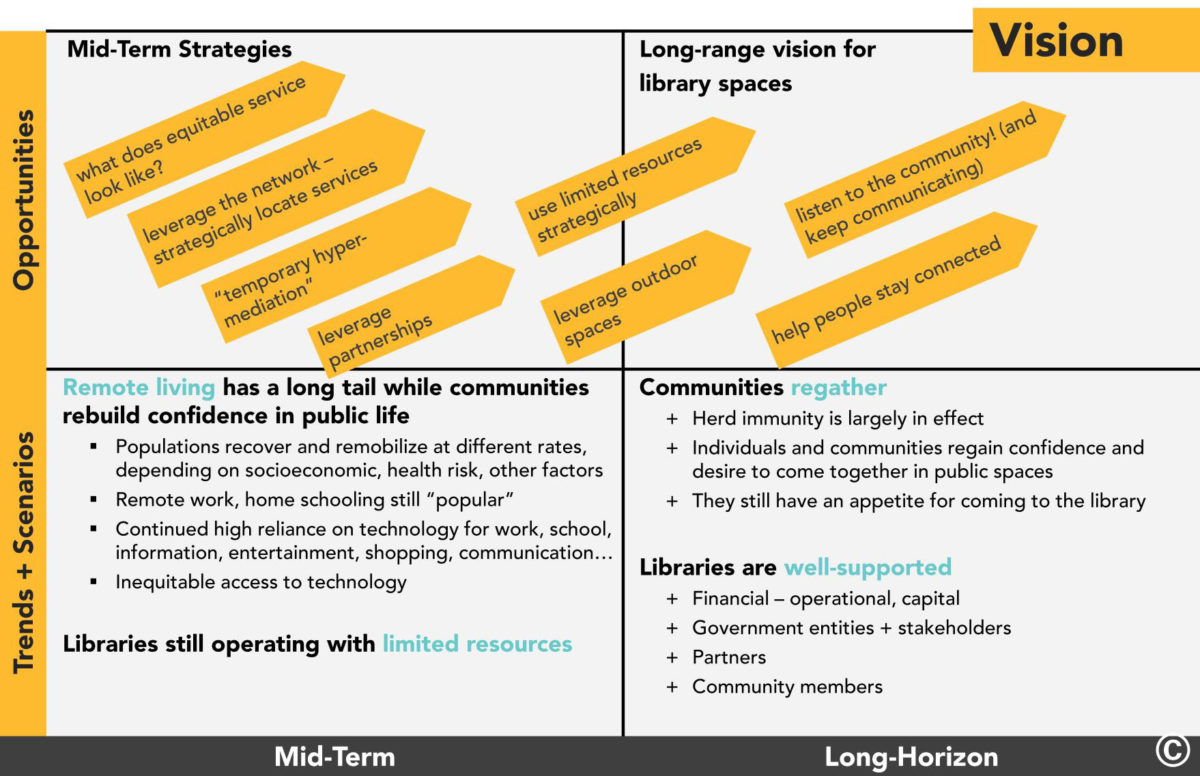
Some have expressed concern that this pandemic and its aftermath will cause the public to lose interest in or waver in their support for the library. Might the increased use of digital services during this time reduce the need (or at least the perceived need) for the library as a public space? Will communities understand or resent libraries for focusing on some services over others during the recovery? Will communities ever feel comfortable leaving home and gathering in public spaces?
Libraries have been facing these kinds of concerns – and proving them wrong – for generations. Their willingness and commitment to evolve along with their communities has always been the foundation for the love and support that libraries receive from their communities.
Salon Participants
- Alene Davis, Multnomah County Library
- Andrew Chanse, Spokane Public Library
- Ann Hammond, Sonoma County Library
- Brett Bonfield, Cincinnati Public Library
- Brian Edwards, Alameda County Library
- Carson Block, Carson Block Consulting
- Cheryl Gould, Fully Engaged Libraries
- David Wark, Hennebery Eddy Architects
- Donna Walker, Jefferson County Public Library
- Heather Dieffenbach, Lexington Public Library
- Heather Norquist, Santa Cruz Public Libraries
- Jane Barker, Hennebery Eddy Architects
- Jarrid Keller, Sacramento Public Library
- Jay Derenthal, Champlin Architecture
- Jayne Klose, Dayton Metro Library
- Julianne Rist, Jefferson County Public Library
- Katie O’Dell, Multnomah County Library
- Laura Whaley, Santa Cruz Public Libraries
- Lori Bowen Ayre, The Galecia Group
- Manya Shorr, Fort Worth Public Library
- Meg Matsushima, Hennebery Eddy Architects
- Melanie Lobsinger, Champlin Architecture
- Molly DeFosse, Cincinnati Public Library
- Monique LeConge Ziesenhenne, Palo Alto City Library
- Nate Hill, Metropolitan New York Library Council
- Patty Wong, Santa Monica Public Library
- Paula Brehm-Heeger, Cincinnati Public Library
- Pedro Reynoso, Chabot College
- Rivkah Sass, Sacramento Public Library
- Sean Casserley, Johnson County Library
- Tim Kambitsch, Dayton Metro Library
- Wylie Ackerman, Deschutes Public Library
- Andrea Gifford, Group 4 Architecture
- Anna Hollingsworth, Group 4 Architecture
- Ben Irinaga, Group 4 Architecture
- Daniel LaRossa, Group 4 Architecture
- David Schnee, Group 4 Architecture
- Dawn Merkes, Group 4 Architecture
- Ha Pham, Group 4 Architecture
- Harding Dowell, Group 4 Architecture
- Jill Eyres, Group 4 Architecture
- Jonathan Hartman, Group 4 Architecture
- Kaifeng Zhang, Group 4 Architecture
- Neha Diggikar , Group 4 Architecture
- Nicole Ghiselli, Group 4 Architecture
Group 4 is grateful for the participation of many of our past and current clients and collaborators in this event. For more information, please email [email protected] or call David Schnee, Group 4 Principal, at 650-871-0709.
Click here to see the salon facilitation slide deck.


